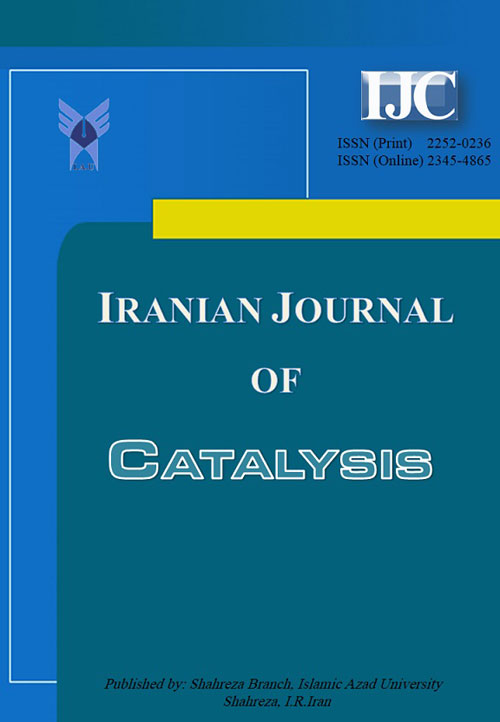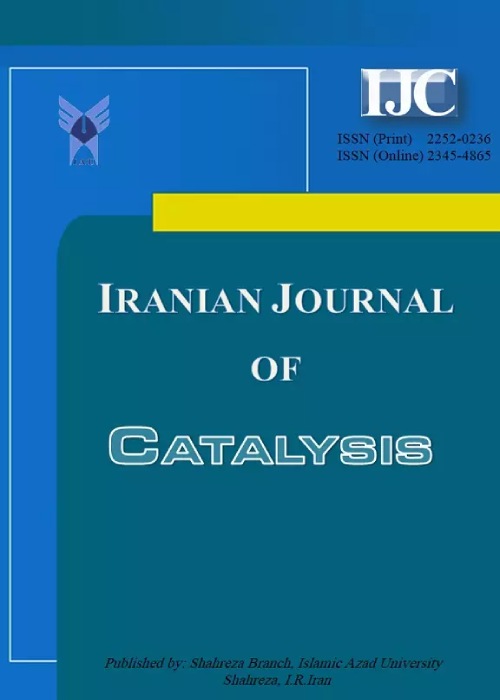فهرست مطالب

Iranian Journal of Catalysis
Volume:10 Issue: 2, Spring 2020
- تاریخ انتشار: 1399/03/12
- تعداد عناوین: 11
-
-
Pages 91-99
In this study, copper manganese oxide (CuMn2O4) nanoparticles were successfully synthesized by a simple sol-gel technique in the presence of lactose as the green capping agent. The lactose concentration effect on the crystalline size and magnetic properties of final products were systematically investigated. The structural, morphological, magnetic, and optical properties of as-obtained products were examined by techniques such as the Fourier transform infrared (FT-IR) spectroscopy, energy dispersive X-ray spectroscopy (EDX), X-ray diffraction (XRD), scanning electron microscopy (FESEM), vibrating-sample magnetometer (VSM) and UV–Vis diffuse reflectance spectroscopy. SEM and VSM results show that lactose concentrations play an important role in the magnetic properties and morphology of CuMn2O4 nanoparticles. Degradation of type of dye (Rhodamine B = Rh B and Methyl orange = MO) under ultraviolet light was examined to assess the feasibility of using CuMn2O4 for photocatalytic activities. To demonstrate the possibility of developing an inexpensive solar cell, FTO/TiO2/CuMn2O4/Pt-FTO, the CuMn2O4 paste was put on the top of the TiO2 through the doctor blade technique.
Keywords: CuMn2O4, nanoparticles, Green capping agent, Photocatalysis, Sol-gel technique -
Pages 101-110
Preparation of 4-aminiquinaldine grafted on silica-coated nano-Fe3O4 particles (Fe3O4@SiO2-AQ) as a novel retrievable heterogeneous nanocatalyst is described. This novel hybrid nanomaterial was applicated for the green synthesis of substituted 2-amino-4H-chromenes via the one-pot condensation reaction of an aldehyde, malononitrile and α-naphthol/β-naphthol/phenol under solvent-free condition. Eco-friendly method, high yield and purity of the desired products, short reaction time along with the ease of the work-up procedure outlines the advantages of these new methodologies over the earlier ones. Surface and magnetic properties of the core/shell hybrid nanoparticles were characterized via transmission electron microscopy (TEM), scanning electron microscope (SEM), X-ray powder diffraction (XRD), energy-dispersive X-ray spectroscopy (EDS), thermogravimetric analysis (TGA/DTA), and Fourier-transform infrared spectroscopy (FT-IR) techniques. This nanocatalyst can be reused at least six times without considerable loss of its performance.
Keywords: 4H-chromenes, Heterogeneous, Hybrid nanomaterial, Green synthesis -
Effect of acidity and physical properties of nanozeolite catalyst on hydrocracking of vacuum gas oilPages 111-117
In this study, beta nanozeolite, ultra-stable Y zeolite (USY) and amorphous silica-alumina (ASA) were synthesized. These compounds were used as the support of hydrocracking catalyst. Ni-Mo/beta zeolite-ASA and Ni-Mo/USY zeolite-ASA catalysts were prepared by the impregnation method. The samples were characterized with X-Ray diffraction (XRD), field emission-scanning electron microscopy (FE-SEM), temperature programmed desorption (TPD) and BET methods. Catalytic behavior of these catalysts was evaluated on hydrocracking of vacuum gas oil at 400 and 55 bar in a fixed bed continuous microreactor. The XRD patterns of the prepared samples determined the phase structure of the samples. FE-SEM images of the nanozeolites indicated that the particle sizes of them are less than 10 nm. The results indicated that the catalyst containing USY with higher pore diameter and acidity was more useful in middle distillate products (87%), while the conversion of the catalyst containing beta zeolite was more than the other catalysts (44.8%).
Keywords: Beta nanozeolite, USY nanozeolite, Acidity, Hydrocracking, Middle distillate -
Pages 119-126
N-sulfonic acid pyridinium -4-carboxylic acid chloride {[Pyridine-N-SO3H-4-COOH]Cl} was synthesized, identified and applied as an effective catalyst for the preparation of pyrido[2,3-d:6,5-d]dipyrimidines by the condensation reaction of various aldehyde with 2-thiobarbituric acid and ammonium acetate under solvent-free conditions.The structure ofcatalyst was studied by various techniques including FT-IR, 1HNMR, 13CNMR, SEM, EDS, TEM, TGA, DTG and XRD analyses.
Keywords: N-sulfonic acid pyridinioum-4-carboxylic acid chloride, Pyrido[2, 3-d:6, 5-d]dipyrimidine, 2-thiobarbituric acid, ammonium acetate, aldehyde, Ionic liquid, Solvent-free -
Pages 127-134In this study, the performance of NiMo catalysts over an amorphous SiO2-Al2O3 and SO4-Al2O3 with various contents of H2SO4 was investigated for the n-hexadecane hydrocracking (n-C16) using a down flow fixed bed micro-reactor. The synthesized catalysts were characterized using BET, XRD, and NH3-TPD analysis. The analysis of the coke formed on the catalysts has been carried out using the TG-TPO. The obtained results indicated that the coke formation was decreased by increasing sulfuric acid content in catalysts. The performance of the catalysts was investigated for n-C16 hydrocracking and the liquid products were analyzed using GC-MS. The catalytic activity increased when sulfuric acid content increased and reached to about 99% conversion using catalyst containing 0.21 wt.% H2SO4.Keywords: Molybdenum, Nickle, catalyst, Hydrocracking, Sulfuric Acid
-
Pages 135-148
In this study, ternary mixed metal oxide (Ce2O3/La2O3/Fe3O4) catalysts were synthesized for reduction of SO2 to sulfur by CH4. The response surface method (RSM) was used to optimize the synthesis conditions. The XRD, FESEM, BET, BJH, EDX and NH3-TPD analyses were performed to characterize the synthesized catalysts. The optimum conditions were obtained for an activated catalyst with 8 wt% La, 16 wt% Fe, and calcination temperature of 650°C. The highest surface area was found to be 71.7 m2.g-1. The validation tests proved that the predicted model was well fitted with the experimental data. Furthermore, the SO2 conversions were compared at various temperatures (550-800 °C) and it was found that the highest reactivity was found for optimum Ce2O3/La2O3/Fe3O4 catalyst. The highest SO2 conversion was found to be 93% at 800 °C. The catalytic results showed that optimum ternary Ce2O3/La2O3/Fe3O4 catalyst had a better performance compared to pure cerium oxide.
Keywords: Ternary Cerium, Lanthanum, Iron oxides, Response Surface Method, Catalyst surface area, Catalytic activity, SO2 reduction -
Pages 149-154
Hydrogen peroxide as an oxidant agent was used for desulfurization of a petroleum hydrocarbon fraction (C10-C22) with boiling range of 175-375 ℃, (light fuel oil) in the presence of acetic acid as catalyst. The oxidation was performed in an ultrasonic bath. It is found that increasing the amount of hydrogen peroxide lead to increase the oxidation rate and so desulfurization efficiency, while the amount of acetic acid has low effect on the desulfurization performance. Residence time and temperature of ultrasonic bath affect significantly on oxidation process. Sulfuric component produced by oxidation process were extracted using methanol as solvent. The number of washing has a considerable effect on the extraction of sulfuric component. So that, the increasing of the number of washing from 1 to 4 times, sulfur content of the hydrocarbon decreased from about 0.554 to 0.154 wt. %. The stability of hydrocarbon during desulfurization was also studied by comparing gas chromatograms of it before and after desulfurization. It was found that the composition of hydrocarbon fraction has no considerable change due to sulfur removal.
Keywords: Oxidation, Desulfurization, Ultrasonic, hydrogen peroxide, acetic acid, Light fuel oil -
Pages 155-161
In the present research, an efficient process for the synthesis of propargylamine derivatives catalyzed by a novel nanocomposite of CuO/MnO2 is reported. CuO/MnO2 nano-catalyst was synthesized by the co-precipitation process and characterized by scanning electron microscopy (SEM), energy dispersive spectroscopy (EDS), X-ray diffraction(XRD), ICP-OES and BET surface area analysis. A broad range of aromatic aldehydes was reacted with amines and phenylacetylene to produce the corresponding propargylamines. The CuO/MnO2 nano-catalyst is recyclable up to 7 repeated runs and it can be easily recovered by simple filtration. The present method affords additional advantages such as straightforward procedure, ease of workup, clean method and moderately short reaction times
Keywords: CuO, MnO2 nanocatalyst, Propargylamine derivatives, amine, Phenylacetylene, aldehyde -
Pages 163-167
Mohammad Dashteh was born in 1994 in Dashteh/ Hamedan, Iran. Having graduated in the field of Pure Chemistry (2016) from Bu-Ali Sina University, Hamedan, Iran, he continued his M.Sc. in 2018 in Organic Chemistry under the supervision of Professor Mohammad Ali Zolfigol. He is currently working towards his Ph.D. under the supervision of Professor Mohammad Ali Zolfigol and Professor Ardeshir Khazaei in the department of chemistry at Bu-Ali Sina University, Hamedan, Iran. His research interest is the design, synthesis, and characterization of task-specific biological-based catalysts and their applications in organic transformations.
Keywords: Phthalocyanine-based catalysts, Effective biomimetic oxidation catalysts, spotlight -
Pages 169-174
Morteza Torabi was born in 1995 in Hamedan, Iran. He received his B.Sc. in Applied Chemistry (2017) and M.Sc. in Organic Chemistry (2019) from Bu-Ali Sina University under the supervision of Professor Mohammad Ali Zolfigol. He is currently working towards his Ph.D. under the supervision of Professor Mohammad Ali Zolfigol at Bu-Ali Sina University. His research interest is the design, synthesis and characterization of acidic magnetic nanoparticles, magnetic ionic liquids, and urea-based compound as catalysts and their applications in organic synthesis.
Keywords: Molecular machines, Rotaxane, Catenanes -
Pages 175-179
Hassan Sepehrmansourie was born in Hamedan, Iran in 1994. He received his B.Sc. in Applied Chemistry (2017) from Bu-Ali Sina University, Iran. He received his M.Sc.in Organic Chemistry (2019) under the supervision of Prof. Mohammad Ali Zolfigol. Also, He was also accepted for a Ph.D. in organic chemistry at the Bu-Ali Sina University in the same year. His research interest is the synthesis, characterization and applications of homogeneous and heterogeneous reagents and catalysts in organic synthesis.
Keywords: Silica sulfuric acid, Multipurpose catalyst


